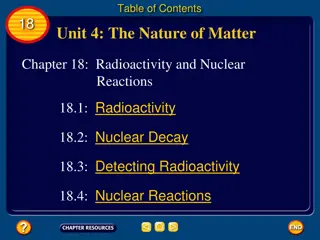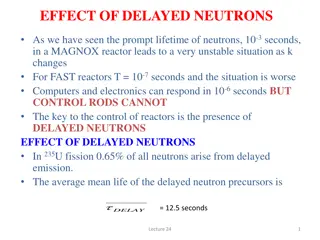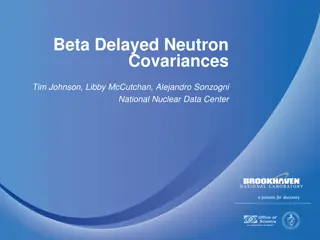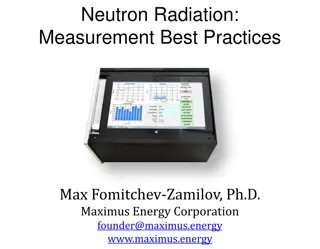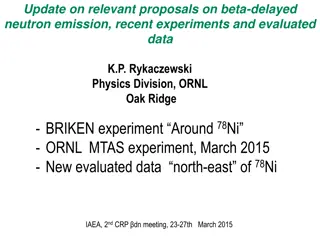Understanding Radioactive Decay and Nuclear Radiation
Radioactive decay is the process in which unstable atomic nuclei emit charged particles and energy, transforming into different elements. This process involves the emission of alpha particles, beta particles, and gamma rays. Alpha particles consist of two protons and two neutrons, beta particles are
4 views • 31 slides
Understanding Models of the Atom: Nucleus, Protons, Electrons
Dive into the fundamental concepts of atoms, exploring their structure with a focus on the nucleus, protons, electrons, and neutrons. Discover how the periodic table reveals crucial information about elements, such as atomic number and mass number. Explore the evolution of atom models and the necess
3 views • 20 slides
Exploring Lunar Surface Radiation Risks and Mitigations Using Bioengineering
Lunar Explorer Instrument for space biology applications, LEIA Mission, addresses radiation health risks for crewed lunar exploration. The project aims to engineer yeast strains to study radiation sensitivity and identify genetic factors affecting cellular response. The instrument suite includes Bio
6 views • 8 slides
Exploring the Composition of the Universe
The universe is a vast expanse consisting of various components. Only 0.4% comprises galaxies, while hydrogen, helium, protons, neutrons, and electrons make up 4%. The remaining 96% includes photons, neutrinos, dark matter, and dark energy. Photons, fundamental particles of light, exhibit different
0 views • 30 slides
The Evolution of Sub-Atomic Particle Theory
Human pursuit of understanding the universe led to the concept of atoms by Democritus and further advancements in sub-atomic particle theory. From the initial idea of indivisible atoms, to the discovery of protons, neutrons, and electrons, to modern experiments with particle accelerators, the journe
2 views • 24 slides
Exploring Neutron Stars: Discoveries and Characteristics
Neutron stars, initially proposed in 1933, have been the subject of various discoveries and studies. They are characterized by their unique properties such as compactness, high density, rapid spinning, and strong magnetic fields. Neutron stars are predominantly composed of neutrons, with other parti
2 views • 23 slides
The Building Blocks of the Universe: Protons, Neutrons, Electrons, Atoms, and Beyond
The universe is composed of just seven different things - protons, neutrons, and electrons- the fundamental building blocks of matter. These particles combine to form atoms like hydrogen, helium, and carbon, which are essential components of our bodies. Understanding the structure and properties of
0 views • 37 slides
Understanding Radioactivity and Nuclear Reactions
Exploring the nature of matter, this chapter delves into radioactivity and nuclear reactions. It covers the composition of atoms, the nucleus with protons and neutrons, and the role of electrons. The strong force holding protons and neutrons together is highlighted, along with the detection of radio
1 views • 126 slides
Understanding Atoms: The Building Blocks of Life
Atoms are the fundamental units of matter, composed of protons, neutrons, and electrons. This article explores the structure of atoms, the atomic theory, and how atoms make up elements. Discover how changing the number of protons can create different elements, and learn about the periodic table and
5 views • 26 slides
Division of Cardiology Morbidity & Mortality Conference Summary
The Division of Cardiology's Morbidity & Mortality Conference discussed a case involving a patient with an LVAD presenting with "low flows," a delayed diagnosis of GIB, and delayed transfusion. The level ofCONTENT for the corresponding Medical Record Number (MRN) includes a timeline of events that l
0 views • 14 slides
Understanding the Role of Delayed Neutrons in Reactor Control
Delayed neutrons play a crucial role in controlling nuclear reactors by providing a means to adjust reactivity. These delayed neutrons, emanating from fission processes in 235U, have a longer mean lifetime compared to prompt neutrons. This characteristic allows for a more manageable reactor operatio
0 views • 15 slides
Understanding Atomic Structure and Subatomic Particles
Delve into the world of atomic structure and subatomic particles to reveal the inner workings of elements. Discover how to determine atomic mass, identify protons, neutrons, and electrons, and interpret the periodic table. Explore the key concepts of isotopes, electron configurations, and the charac
0 views • 6 slides
Delayed Infrastructure Projects Progress Report
The presentation to the Roads and Transport Portfolio Committee highlighted progress on delayed infrastructure projects. Details included the status of projects like K46 William Nicol and P39/1 Muldersdrift, with reports on work completion, financial impacts, and timelines for completion. Contractor
0 views • 23 slides
Exploring the Nature of Subatomic Particles and Light
Explore the intricate world of subatomic particles such as electrons, protons, and neutrons, and delve into the dual nature of light as both particles and waves. Discover the structure of atoms, their isotopes, atomic number, mass number, and the fundamental discoveries in the field of physics, incl
1 views • 16 slides
Exploring Parts of the Atom: A Visual Journey
Delve into the discovery of the constituents of an atom, from the negatively charged particles in the electron cloud to the positively charged particles in the nucleus. Learn about protons, neutrons, and the particle with no charge as they form the building blocks of matter. Engage with visually sti
4 views • 17 slides
Understanding Organic Chemistry: Introduction to Carbon Compounds
Organic chemistry is the study of carbon compounds, with carbon's unique electronic structure allowing for a vast array of compounds. This field touches many aspects of life, from medicines to polymers. The nucleus of an atom, comprising protons and neutrons, is surrounded by electrons occupying orb
1 views • 5 slides
Understanding Atomic Structure: Electrons, Energy Levels, and Historical Models
The atomic model describes how electrons occupy energy levels or shells in an atom. These energy levels have specific capacities for electrons. The electronic structure of an atom is represented by numbers indicating electron distribution. Over time, scientists have developed atomic models based on
0 views • 5 slides
Understanding Atoms, Ions, and Isotopes in Chemistry
Atoms are neutral with equal protons and electrons. Ions are charged atoms resulting from gaining or losing electrons, while isotopes are atoms with varying numbers of neutrons. The atomic number always signifies the number of protons in an atom, unaffected by electron or neutron changes. Explore th
2 views • 5 slides
The Economic Impact of Delayed Diagnosis of Axial Spondyloarthritis in the UK
Delayed diagnosis of axial spondyloarthritis in the UK leads to significant physical, emotional, and financial burdens for patients. This research aims to quantify the full economic cost of diagnostic delays, highlighting the need for timely identification and management of this incurable form of in
0 views • 11 slides
Understanding Atomic Structure, Elements, Mixtures, and Compounds
Exploring the basics of atomic structure, including elements, mixtures, and compounds. Learn about single atoms, molecules of elements, and compounds formed by different elements. Understand the relationship between protons, neutrons, electrons, atomic number, and atomic mass. Test your knowledge on
0 views • 6 slides
Insights on Breast Cancer in Young Women: Diagnosis Challenges and Fertility Preservation
Recent scientific presentations shed light on delayed diagnosis of breast cancer in young women, highlighting the need for increased education and awareness. Findings indicate a concerning rate of delayed diagnoses, with many patients lacking essential breast health education. Moreover, research on
5 views • 11 slides
Enhanced Directional Extraction of Very Cold Neutrons Using Diamond Nanoparticle Reflector
Alexander Nezvanov, a researcher at Frank Laboratory of Neutron Physics, presented a study on enhanced directional extraction of very cold neutrons using a diamond nanoparticle powder reflector. Very cold neutrons (VCN) have unique properties making them ideal for various applications in neutron tec
0 views • 11 slides
Mechanism of Low-Energy Nuclear Reactions in Low-Temperature Plasma
This work discusses nuclear-chemical processes underlying low-energy nuclear reactions in low-temperature plasma environments, focusing on the initiation of artificial radioactivity in metal cathodes under protium- and deuterium-containing nonequilibrium plasma conditions. The role of electrons with
4 views • 6 slides
Exploring Nucleonic Halos in Isobar-Analog States at Kurchatov Institute
The research at Kurchatov Institute focuses on investigating nucleonic halos in isobar-analog states (IASs) of nuclei, aiming to understand the structure and properties of exotic nuclei with neutron halos. Neutron halos, characterized by enlarged radii of valence neutrons, have been observed in both
0 views • 15 slides
Status Update on GRANIT Spectrometer at Les Houches (August 19, 2024)
GRANIT aims to increase observation time of neutrons in gravitational states and enhance precision of measurements. Details about the clean room, UCNs hunting, and progress made in 2010 are outlined, emphasizing the need for system reliability and improvement. Significant steps have been taken towar
0 views • 34 slides
Developing Delayed Gratification: A Lesson in Self-Control
Explore the concept of delayed gratification through activities like the marshmallow test, assignments due, and reflection on personal goals. Discover strategies for overcoming distractions and achieving long-term objectives. Embrace the challenge of delayed gratification for personal growth and suc
0 views • 24 slides
Understanding Ions and Their Importance in Your Body
Neutral atoms have the same number of protons and electrons, with the charge of the nucleus always positive. The mass number is the sum of protons and neutrons. The number of neutrons can be calculated by subtracting the atomic number from the mass number. Ions are atoms with a positive or negative
0 views • 15 slides
Theoretical Calculations of Beta-Delayed Neutrons and Sensitivity Analyses
In this talk by Futoshi Minato from JAEA Nuclear Data Center, topics covered include delayed neutron emission probabilities, incident neutron energy dependence, sensitivity analysis with JENDL evaluated libraries, and important precursors in r-process nucleosynthesis. Theoretical calculations are pr
0 views • 27 slides
Retirement Home Fire Safety Incident Report
A retirement home regulated under the Retirement Home Act, 2010 experienced a fire safety incident involving smoke alarms and evacuation procedures. The fire safety plan, approved in 2012, is under review. During a fire drill in 2014, a tenant failed to notify staff, resulting in a delayed response.
0 views • 20 slides
Understanding Copper Atoms: Protons, Electrons, Neutrons, Isotopes
Explore the intricacies of copper atoms, including calculations for protons, electrons, neutrons, mass number, and isotopes. Learn about the importance of oxidation states and electron configurations from the periodic table. Discover the isotope notation and final details for the element copper.
0 views • 8 slides
Analysis of Mott Delayed Helicity Information and Asymmetry Results
This content provides detailed information on Mott Delayed Analysis along with Helicity Info, Mott Asymmetry results, and Charge Asymmetry data. It discusses the differences in asymmetry measurements using FADC Helicity and Scalers Helicity, highlighting the reasons behind the slight variations obse
0 views • 4 slides
Exploratory Study on Delayed Discharges Among Inpatients with Learning Disabilities
This online poster presentation discusses the issue of delayed discharges among inpatients with learning disabilities, focusing on reducing delays and improving opportunities for a meaningful life. The study explores dynamic hypotheses developed in collaboration with healthcare professionals and sta
0 views • 4 slides
IEEE 802.11-19/0709r0 - Immediate and Delayed Feedback May 2019
The document discusses immediate and delayed feedback mechanisms in IEEE 802.11-19/0709r0, focusing on parameters, feedback types, and ranging options. It explores variations in feedback direction and types, proposing options for phase shift feedback and distinguishing between RSTA-to-ISTA and ISTA-
0 views • 6 slides
Insights into Beta-Delayed Neutron Covariances by Tim Johnson, Libby McCutchan, and Alejandro Sonzogni
Comprehensive analysis and visualization of beta-delayed neutron covariances, fission yields, and their implications in nuclear physics applications. The research covers calculations of delayed nu-bar, neutron probabilities, and recommendations for various systems. Disagreements in fission yields fo
0 views • 26 slides
Factors Influencing Delayed Prescribing in UK Primary Care
Factors influencing delayed prescribing in UK primary care were examined through a study involving general practitioners (GPs) and prescribing scenarios for respiratory tract infections. Clinical features, patient preferences, and practitioner tendencies were key factors affecting the decision to pr
0 views • 5 slides
Understanding Cultural Influence on Delayed Child Sexual Abuse Disclosure in the Vhavena Tribe
Exploring the intersection of culture, tradition, and delayed disclosure of child sexual abuse within the Vhavena Tribe. The study delves into the complexities of disclosure, the unique context of CSA in cultural norms, and behaviors, guided by the Afrocentric theory. Methodology involves interviews
0 views • 15 slides
Neutron Radiation Measurement Guidelines and Techniques
Understanding neutron detection basics, absorption cross-section, moderators, positioning, and common detector types is crucial for accurate measurements. Neutrons vary in energy levels, requiring specific detection techniques. Thermal neutrons are easier to detect than fast ones, with materials lik
0 views • 34 slides
Understanding Atoms and Isotopes in Chemistry
Understanding atoms and isotopes is essential in chemistry. Atoms consist of protons, neutrons, and electrons that determine their properties. Isotopes are atoms of the same element with different atomic masses due to varying numbers of neutrons. Learning how to determine subatomic particles and ato
0 views • 17 slides
Addressing Delayed Transfers of Care in Nottingham & Nottinghamshire Partnership
The Nottingham & Nottinghamshire Partnership, jointly funded by NHS England, is focused on tackling Delayed Transfers of Care (DToC). Through the Building Health Partnerships program, efforts are being made to understand and improve the discharge process for patients. Local leaders emphasize the imp
0 views • 14 slides
Updates on Beta-Delayed Neutron Emission Experiments and Data Evaluation
Recent experiments and evaluated data concerning beta-delayed neutron emission, specifically focusing on proposals, measurements, collaborations, and motivations within the field of nuclear physics.
0 views • 36 slides







